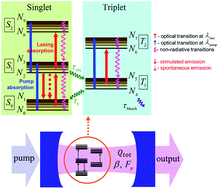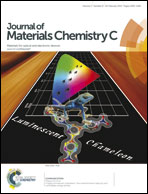Modeling of threshold and dynamics behavior of organic nanostructured lasers†
Abstract
Organic dye molecules offer significant potential as gain media in the emerging field of optical amplification and lasing at subwavelength scales. Here, we investigate the laser dynamics in systems comprising subwavelength-structured cavities that incorporate organic dyes. To this end, we have developed a comprehensive theoretical framework able to accurately describe the interaction of organic molecules with any arbitrary photonic structure to produce single-mode lasing. The model provides explicit analytic expressions of the threshold and slope efficiency that characterize this class of lasers, and also the duration over which lasing action can be sustained before the dye photobleaches. Both the physical properties of the dyes and the optical properties of the cavities are considered. We also systematically studied the feasibility of achieving lasing action under continuous-wave excitation in optically pumped monolithic organic dye lasers. This study suggests routes to realize an organic laser that can potentially lase with a threshold of only a few W cm−2. Our work puts forward a theoretical formalism that could enable the advancement of nanostructured organic-based light emitting and sensing devices.


 Please wait while we load your content...
Please wait while we load your content...